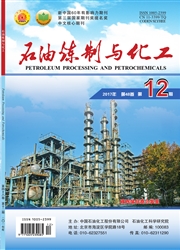

 中文摘要:
中文摘要:
采用超声浸渍法制备了不同碱性金属改性的Cu-Fe双孔载体催化剂,利用Nz物理吸附、Hz—TPR、XRD、XPS等表征手段考察了Li,Ca,Na,K等碱性金属对催化剂结构的影响,并在固定床反应器中评价了催化剂的低碳醇合成反应性能。结果表明:将小孔硅溶胶与大孔硅凝胶结合可形成SiO:一SiOz双孔载体结构;Li和ca的添加可促进CuFe双孔载体催化剂表层CuO的生成,降低Fe2O3。的含量,削弱Cu—Fe之间的作用力,从而促进甲醇产物的生成;Na和K助剂的添加则可促进Cu、Fe氧化物在催化剂表层的生成,加强Cu—Fe协同作用,从而提高低碳醇合成反应的活性和cz以上醇类产物的选择性;与其它碱性金属相比,K助剂的添加使CuFe双孔载体催化剂具有最高的低碳醇合成反应活性和醇时空产率。
 英文摘要:
英文摘要:
Cu-Fe bimodal pore catalysts modified with basic metal additives for higher alcohols synthesis (HAS) were prepared by an ultrasonic impregnation method. The study was undertaken to investigate the effects of various basic metal additives on the microstructures and HAS performances of catalysts. Several techniques, including N2 physical adsorption, temperature programmed reduction of hydrogen, X-ray diffraction and X-ray photoelectron spectroscopy, were combined to characterize these catalysts. The characterization results indicated that bimodal pore support was formed with the addition of small pore silica sol into the macroporous silica gel. Adding additives containing Ca and Li into Cu-Fe bimodal catalyst increased the amount of CuO and decreased that of Fe203 on the surface layer of the catalyst, which could weaken the interaction of Cu-Fe-O and promote the formation of methanol. The addition of Na and K additives increased the amounts of copper and iron species on the surface layer, enhancing the synergistic effect of Cu-Fe and improving the HAS activity and selectivity of C2+ OH. Among these four basic metal additives, catalyst with K additive exhibited the best activity and space time yield of higher alcohols.
 同期刊论文项目
同期刊论文项目
 同项目期刊论文
同项目期刊论文
 Effect of H2/CO ratio on microstructure and catalytic performance of precipitated iron-based catalys
Effect of H2/CO ratio on microstructure and catalytic performance of precipitated iron-based catalys Auto-thermal reforming of biomass raw fuel gas to syngas in a novel reformer: promotion of hot-elect
Auto-thermal reforming of biomass raw fuel gas to syngas in a novel reformer: promotion of hot-elect Effect of iron promoter on structure and performance of CuMnZnO catalyst for higher alcohols synthes
Effect of iron promoter on structure and performance of CuMnZnO catalyst for higher alcohols synthes Transformation of carbonaceous species and its influence on catalytic performance for iron-based Fis
Transformation of carbonaceous species and its influence on catalytic performance for iron-based Fis Preliminary investigation on hydrogen-rich gas production by co-steam-reforming of biomass and crude
Preliminary investigation on hydrogen-rich gas production by co-steam-reforming of biomass and crude Different Methods for Evaluating Pinewood Sawdust Pyrolysis Kinetics by Thermogravimetry Mass Spectr
Different Methods for Evaluating Pinewood Sawdust Pyrolysis Kinetics by Thermogravimetry Mass Spectr Synthesis of Fe3O4-nanocatalysts with different morphologies and its promotion on shifting C5 + hydr
Synthesis of Fe3O4-nanocatalysts with different morphologies and its promotion on shifting C5 + hydr Influence of manganese promoter on co-precipitated Fe-Cu based catalysts for higher alcohols synthes
Influence of manganese promoter on co-precipitated Fe-Cu based catalysts for higher alcohols synthes Ultrasonic-assisted production of biodiesel from transesterification of palm oil over ostrich eggshe
Ultrasonic-assisted production of biodiesel from transesterification of palm oil over ostrich eggshe Preparation and characterization of carbonaceous adsorbents from sewage sludge using a pilot-scale m
Preparation and characterization of carbonaceous adsorbents from sewage sludge using a pilot-scale m Study of thermal decomposition and kinetics of biomass/Swill-cooked dirty oil blends during co-pyrol
Study of thermal decomposition and kinetics of biomass/Swill-cooked dirty oil blends during co-pyrol Production of light olefins from biosyngas by two-stage catalytic conversion process via dimethyl et
Production of light olefins from biosyngas by two-stage catalytic conversion process via dimethyl et Decentralized Heating in a Rural Village using Biomass Gasification and Anaerobic Digestion: Economi
Decentralized Heating in a Rural Village using Biomass Gasification and Anaerobic Digestion: Economi Analysis of product distribution and characteristics in hydrothermal liquefaction of barley straw in
Analysis of product distribution and characteristics in hydrothermal liquefaction of barley straw in Molecular Dynamics Simulations of Interaction between the Mixture of Glycerol and 1,6-hexanediol and
Molecular Dynamics Simulations of Interaction between the Mixture of Glycerol and 1,6-hexanediol and Hydrogen from biomass degradation production by aqueous-phase reforming : An overview on the catalys
Hydrogen from biomass degradation production by aqueous-phase reforming : An overview on the catalys Influence of alkali catalyst on product yield and properties via hydrothermal liquefaction of barley
Influence of alkali catalyst on product yield and properties via hydrothermal liquefaction of barley Chuangzhi Wu,Influence of manganese promoter on co-precipitated Fe-Cu based catalysts for higher alc
Chuangzhi Wu,Influence of manganese promoter on co-precipitated Fe-Cu based catalysts for higher alc 期刊信息
期刊信息
